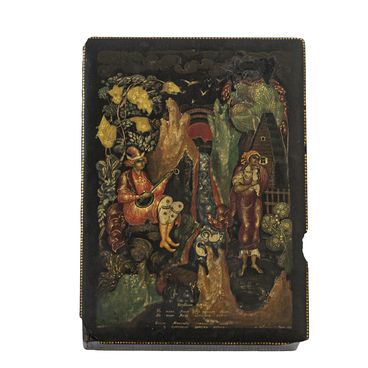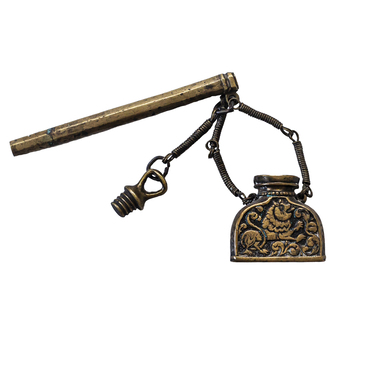Historians believe that the first jewelry boxes appeared in the Middle East several thousand years ago, whereas in Europe, they began to be used in the Middle Ages. In Kievan Rus', a small trunk or chest was always kept in every house. They contained memorabilia, letters, and jewelry.
In Russian, the word “shkatula” (an old word for a box) was first mentioned in 1598, and “shkatulka” (small jewelry box) in 1610. According to Max Fasmer’s etymological dictionary of the Russian language, it came from Polish, Middle Latin, and Italian and meant “box”.
The value of the box depended on its material. Therefore, boxes made of ivory, noble metals — gold or silver, covered with enamel, leather, precious or semiprecious stones were highly valued. Engraving, inlay, filigree, or cloisonné enamel were often used to decorate them.
The box displayed in the exhibition belonged to the owner of the estate, Maria Kolokolnikova (maiden name Karpinskaya). She was born in 1881 into the family of a collegiate counselor, Arkady Karpinsky. In 1903, Maria married merchant Vladimir Kolokolnikov.
Vladimir’s father, Tyumen merchant and philanthropist Ivan Kolokolnikov, purchased the estate for the family. He came from the petty bourgeoisie, became a merchant of the First Guild, dealt in tea and sugar. Kolokolnikov presented his products at the Irbit, Nizhny Novgorod and Ivanovo fairs. From 1866 to 1869, he served as a glasny (elected member of the city council) for the Tyumen City Duma. In addition, the merchant was elected as the director of the Tyumen public bank and held the title of Honorary Overseer of the Nikolsky Parochial School in Tyumen.
At the end of 1880, Kolokolnikov bought the mansion which belonged to merchant Ivan Ikonnikov and completely rebuilt it. In June 1891, Kolokolnikov was elected as a member of the committee tasked with providing food to the poor residents of Tyumen. On September 13, 1891,
In Russian, the word “shkatula” (an old word for a box) was first mentioned in 1598, and “shkatulka” (small jewelry box) in 1610. According to Max Fasmer’s etymological dictionary of the Russian language, it came from Polish, Middle Latin, and Italian and meant “box”.
The value of the box depended on its material. Therefore, boxes made of ivory, noble metals — gold or silver, covered with enamel, leather, precious or semiprecious stones were highly valued. Engraving, inlay, filigree, or cloisonné enamel were often used to decorate them.
The box displayed in the exhibition belonged to the owner of the estate, Maria Kolokolnikova (maiden name Karpinskaya). She was born in 1881 into the family of a collegiate counselor, Arkady Karpinsky. In 1903, Maria married merchant Vladimir Kolokolnikov.
Vladimir’s father, Tyumen merchant and philanthropist Ivan Kolokolnikov, purchased the estate for the family. He came from the petty bourgeoisie, became a merchant of the First Guild, dealt in tea and sugar. Kolokolnikov presented his products at the Irbit, Nizhny Novgorod and Ivanovo fairs. From 1866 to 1869, he served as a glasny (elected member of the city council) for the Tyumen City Duma. In addition, the merchant was elected as the director of the Tyumen public bank and held the title of Honorary Overseer of the Nikolsky Parochial School in Tyumen.
At the end of 1880, Kolokolnikov bought the mansion which belonged to merchant Ivan Ikonnikov and completely rebuilt it. In June 1891, Kolokolnikov was elected as a member of the committee tasked with providing food to the poor residents of Tyumen. On September 13, 1891,



